Learn to Drive
Driving lesson brief 7. Crossroads
Introduction
Once you can deal with approaching and emerging from basic T-junctions with little support from your instructor the next logical step is to look at crossroads and other more complex junctions. For example junctions with restricted views, acute angles and steep gradients. Again you would be looking to undertake this training in housing estates with minimal traffic at this stage.
![]() Lesson objectives
Lesson objectives
By the end of this lesson you should be able to:
- Recognise crossroads in advance and take extra observations on approach
- Turn left and right from the major road while observing the priority of oncoming traffic
- Emerge left and right from the minor roads, while observing the priorities of traffic on the major road and those on the opposing side road
- Understand the extra observations you need to take at crossroads and the priorities you need to observe
- Recognise when you might use near-side to near-side or off-side to off-side when turning right at a crossroads
- Treat unmarked crossroads as a give way junction while being careful to assess and act upon the actions of other drivers
- Recognise when it is possible to treat a staggered crossroads as two side roads and when it is not
- Deal with more complex junctions that include steep gradients, acute angles and restricted views
Subject Brief
During this lesson we will learn about how to turn into side roads at crossroads and how to emerge from them.
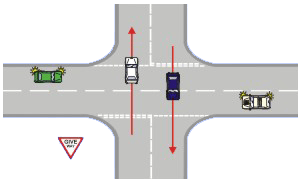 Approaching crossroads to turn
Approaching crossroads to turn
Approaching to turn into a side road at a crossroads is slightly different from turning into a side road at a T or Y junction. Firstly, traffic may emerge from either side road and cross your path. While you have priority you must be prepared to stop if someone foolishly crosses your path. This may also occur when you intend to go ahead which is why you always take extra observations into the side roads of a crossroads before you pass.
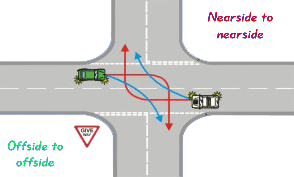 Secondly, when turning right you may be faced with an oncoming vehicle also wanting to turn right. In this instance neither vehicle has priority. Usually vehicles turn nearside to nearside in this situation although offside to offside is safer because you can more easily observe oncoming traffic before turning. Road markings may also dictate which method is used.
Secondly, when turning right you may be faced with an oncoming vehicle also wanting to turn right. In this instance neither vehicle has priority. Usually vehicles turn nearside to nearside in this situation although offside to offside is safer because you can more easily observe oncoming traffic before turning. Road markings may also dictate which method is used.
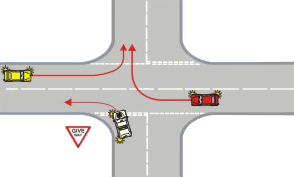 Emerging at crossroads
Emerging at crossroads
If no vehicles are emerging from the side road opposite, emerging to the left and the right is identical to T junctions with the exception that you need to be prepared to take advantage of opportunities to proceed that might arise as a result of the vehicles on the major road slowing down to turn into the side road opposite.
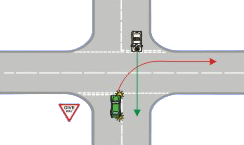 Priorities
Priorities
Where differences do occur is when vehicles in the opposite side road need to cross your path or follow the same path. Who has priority in these examples is the same as if the two minor side roads were one major road. However do not assume that the other driver will comply.

In the first example below the green cars progress is blocked by queuing traffic therefore you may proceed despite not having priority because the green car is giving you priority. In the second example it is clear that you can turn without impeding the progress of the green car as the vehicle will need to stop while the driver takes proper observations.
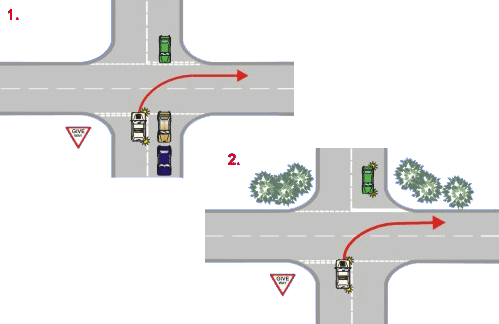 Emerging at staggered crossroads
Emerging at staggered crossroadsPriorities between the traffic on the opposing side roads is not so clear at staggered crossroads therefore we have to be particularly careful.
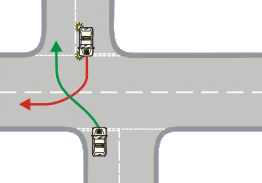
Emerging at unmarked crossroads
Neither road is the major road therefore proceed with extreme caution and be prepared to stop. Anticipating other drivers actions and driving at a speed that enables you to stop is critical. Priority regarding oncoming vehicles is not changed.
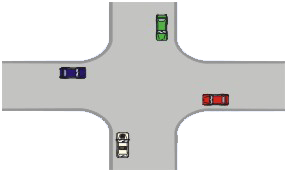
Making progress
At this stage you should have developed the ability to recognise and act upon most opportunities to make progress safely and therefore maintain the flow of traffic. Driving up to the maximum speed limit (if safe to do so), approaching junctions or turning into side roads without undue hesitancy, and emerging out of side roads at the earliest possibility is all part of this skill. This skill will be tested by getting you to negotiate junctions with much higher volumes of traffic. The basics of this skill will have been developed in the previous part of this course.
Highway code practical references
Rule: 181